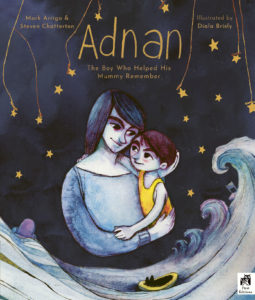Guest blog by Steven Chatterton, author of Adnan
Adnan has been on a journey for over 6 years now, and we’re so thrilled that his next stop will be in classrooms around the country as part of Refugee Week. This beautifully illustrated children’s picture book (by immensely talented artist Diala Brisly), began its life as a short film, for which Mark and I set out with two defining goals:
1) To engage people’s hearts with a very human story as a response to the horrible, dehumanising headlines about displaced people fleeing war zones. We had both been volunteering with charities that worked with children and refugees, and wanted to put our creative energies into challenging these dominant narratives;
2) To bring together a creative fusion of people from different backgrounds for a project that would provide a warm, integrating welcome to a displaced family rebuilding their lives in the UK. The primary focus here would be to work with a refugee child at the heart of this creative process.
That child was 11-year-old Ayham. 3 years prior to making the film, he and his family were living in Aleppo, before their neighbourhood was destroyed, forcing them to flee to safety. His father had made the arduous journey to the UK, where they are all now happily settled, and Ayham is currently applying to university. They are the loveliest family, who are in our hearts forever.
We simply wanted to tell a heartfelt story to engage empathetic souls. To create a little piece of art that spoke to the world we were seeing. The reactions it received from film festival audiences around the world (over a two-year film festival run) has been humbling, winning multiple awards, often voted for by children.
During lockdown, in 2020, when the film was beginning its stuttering festival run, we were encouraged to write Adnan as a children’s picture book, to engage with a whole new – and even younger – audience. If film is primarily a visual language, condensing a story into less than 500 words is like writing poetry.
The narrative structure of the film was something to work from, the challenge being to condense it into essentially 17 spreads. We then fine tuned our initial draft with incredible support from our publisher, Frances Lincoln, who then found Syrian artist Diala Brisly. Her visual interpretation of the words is awe-inspiring. She’s a true artist, who brought the story to life in ways that we could never have imagined. Working with Diala was mainly about giving her space to follow her own instincts, to interpret the words in her own way. She brings to the story her own experience, both as a Syrian refugee herself, and also someone with a long history of using art for social change. We are so blessed to have worked with her.
At its heart this is a story about a boy and his mother. Two figures on a new frontier, survivors facing fresh challenges, forging towards their future. Although this is a fictional story, it represents a reality faced by so many in the world today. While the film was focussed on Syrian refugees, we wanted to widen the book, so Adnan represents all those who are forcibly displaced from their home countries.
We want Adnan to tell a human story, far from politics, of a boy trying to heal his mother from the damage caused by a conflict they never asked for. A story that breaks down barriers and reminds us that we’re all just people. The character of Adnan is an ordinary boy forced into an extraordinary situation, something true for many children across the planet. He is an archetype for the child who carries on regardless, with optimism and can-do spirit.
We’re glowing in the knowledge that the message of the book and the film – of choosing love over seeing difference – will continue to reach so many people in this new format, and we’re so grateful to be part of Refugee Week.
